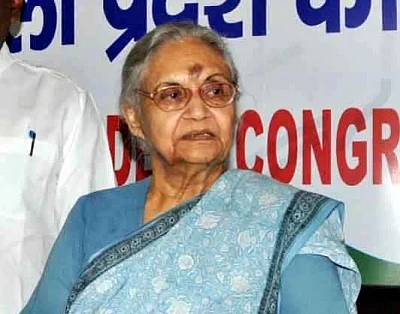By Nivedita Singh
New Delhi, July 20 (IANS) Delhi, which was the scene of Sheila Dikshit's greatest political triumph as she led Congress to power there in three successive Assembly elections to become its longest-serving Chief Minister, also made her witness the most humiliating defeats of her career with her loss in the Assembly and Lok Sabha polls.
Her three tenures were remembered for development, infrastructure and reforms as well as for rising crime, financial irregularities and wrongdoings during the Commonwealth Games.
She transformed the city by pushing the work on public transport, including Delhi Metro, and also for giving close to 90 flyovers to the city. She was also credited for implementation of court order for CNG-based public transport in Delhi, which is the most polluted national capital in the world currently. She also ensured that the industries are moved out of the residential areas of Delhi.
Dikshit was credited for giving several elevated roads and underpasses to the city along with improved water and electricity condition, and building numerous hospitals, colleges and universities.
The iconic Signature Bridge over the Yamuna and the recently-inaugurated RTR flyover were her products and the work too was initiated in her tenure. Making the ring road single free to improve the traffic flow was also her gift to the city.
Bhagidari (partnership) -- her famous citizen partnership programme -- too brought reform with citizen groups working as partners for the city's development.
She also enjoyed the support of the Centre even when the BJP was in power. Her administrative skills and rapport with most party legislators was a plus point too.
Day by day under her rule, the city saw rapid development in almost all fronts, barring law and order, which was under the control of the Central government. However, most people in Delhi, including her successor Arvind Kejriwal, blamed her government for the rise in rapes in the national capital.
Under her leadership, the Congress won an impressive 52 of the 70 seats in Delhi in 1998. She repeated similar magic in 2003 and 2008 as well.
After such a long period of rule, her supporters had also started making plans for her to assume a greater role in national politics but then the preparations for the 2010 CWG happened and Dikshit was targetted for the cost of projects escalated many times over amid allegations of rampant corruption.
Her tenure could have survived the Common Wealth corruption charges, but then came the Anna Hazare movement.
Another jolt was the gang-rape and death of a young woman in a moving bus in Delhi in December 2012 and the frenzied protests that followed hurt Dikshit badly.
She tried to sail through the storm but the repeated attacks brought an end to her long tenure.
Kejriwal also blamed her for increased prices of daily food items, shortage of water and rising power bills in the city and used these for attacking her.
After losing the 2013 Assembly polls, Dikshit came back into state politics early this year when she was appointed the state party chief ahead of the Lok Sabha polls. Though the Congress saw its vote share increase since the last Lok Sabha and Assembly polls, it could not win any of the city's seven seats, including North East Delhi from where she had herself contested.
(Nivedita Singh can be contacted at nivedita.singh@ians.in)
--IANS
nks/vd
(At The Quint, we question everything. Play an active role in shaping our journalism by becoming a member today.)
